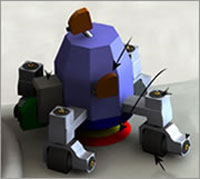| May 13, 2013 | |
New smart robots to improve inspection of nuclear plants |
|
| (Nanowerk News) Nuclear power accounts for one sixth of the European Union (EU)'s energy consumption, and there are power plants in 14 of the 27 member states. Safety is a priority and there are regular maintenance checks on every aspect of the plants. But what happens if cracks appear in the machinery that are so small and deep that they escape the human eye? And how can one check every corner of a nuclear reactor when some areas are, by necessity, shrouded in radiation? | |
 These issues have been addressed by a pan-European research project, NozzleInspect, backed by €1.1 million in EU funds. The team behind the project has built a remote controlled prototype robot that uses state of the art ultrasonic probes to detect tiny, millimetric defects in the nozzle, a crucial, sensitive component used to control the flow of water that cools the nuclear reactor. The new technology cuts down human intervention and potential exposure to radiation. "The NozzleInspect robot can identify any cracks, porous walls or other defaults inside the material to a greater degree (30% more precise than any other technology), while keeping humans away from radiation," says project leader Dimos Liaptsis. Nozzle sections, which are made from steel, can be particularly susceptible to cracks from thermal fatigue and stress corrosion. Most inspections are carried out with conventional ultrasonic testing that requires frequent changes of the probes in a high radiation environment, and facilities can be shut down for days while human operators physically carry out recalibration tasks. Faster, cheaper and more accurate inspection systems are thus considered essential to ensure the continued safe operation of the nuclear facilities. |
|
| The NozzleInspect project has developed a flexible probe attached to a low-cost robot to inspect nozzle weld areas. The project gathers nuclear research and safety partners in Britain, France, Spain, Poland, Lithuania and Greece, each bringing complimentary skills to the table, from ultrasonic modelling and simulations to mechanical systems design and motion control programming. The partners involved in the project (most of which are SMEs) will benefit if the system is commercialised. They have also benefitted from the inter-European collaboration - coming from different countries and different areas of expertise - creating strong ties and promoting the exchange of expertise that benefits their overall research capabilities. | |
| Using remote-controlled robots means the calibration and set up of the scanner can be completed outside the vicinity of the nuclear reactor. "Operators take just a couple of minutes to install the robot on the nozzle, and they can then do the calibrations remotely," says Liaptsis. Thanks to a 3D beam steering capability, the developed prototype is able to inspect the entire volume of the weld in a single operation. Liaptsis says the prototype has also improved the accuracy of the monitoring – it is 30% more precise than current probes - helping provide better data about the nozzle's life span and deterioration rate. |
| Source: European Commission |
